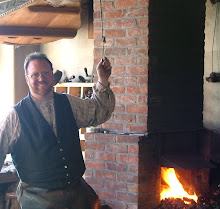 Many objects made in the blacksmith shop got no special decoration after forging. Nails, horseshoes, and clothing hooks may have been scrubbed with a wire brush and put to use. But
Many objects made in the blacksmith shop got no special decoration after forging. Nails, horseshoes, and clothing hooks may have been scrubbed with a wire brush and put to use. But  some items received fancier treatment. Cooking forks, spatula, and ladles often received “whitesmithing.” This means the metal surface was smoothed with a file and given a bright, shiny finish.
some items received fancier treatment. Cooking forks, spatula, and ladles often received “whitesmithing.” This means the metal surface was smoothed with a file and given a bright, shiny finish. 
Items that were going to be decorated in that fashion needed special treatment. The smith would carefully forge the item to as close as possible to the finished surface. Then time was spent with a succession of files shaping the iron. The traditional saying is that the smith needed to “forge thick and file thin.” He needed to allow enough material for filing. But not too much extra metal, as you could spend hours filing the surface. So a related saying admonished that “five minutes at the Anvil saves half an hour at the bench!"
Cooking hardware, like spatulas, was often filed smooth. The spatula was forged to rough shape and filed to a smooth shape and surface. We have examples in the shop of a freshly forged spatula, newly forged spatula, and spatula from past seasons.

No comments:
Post a Comment